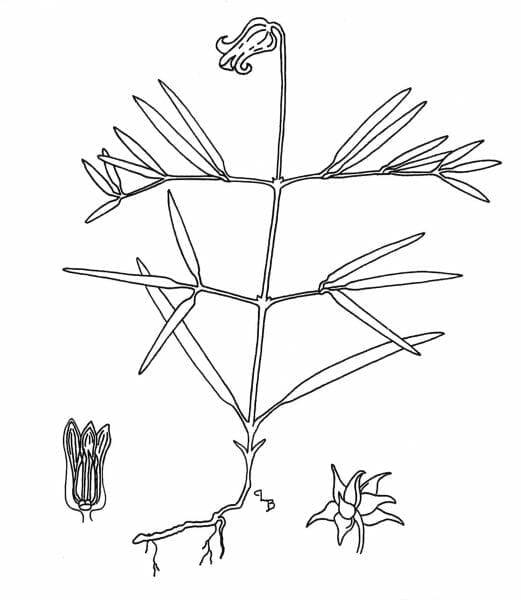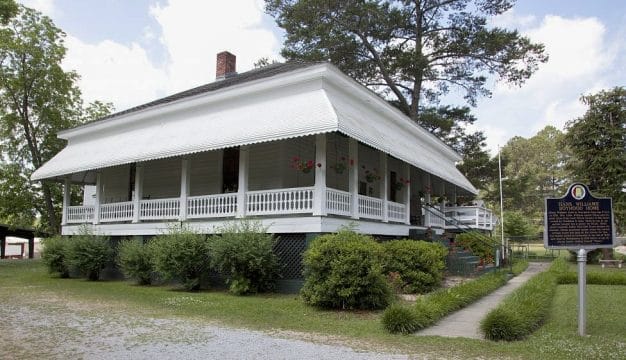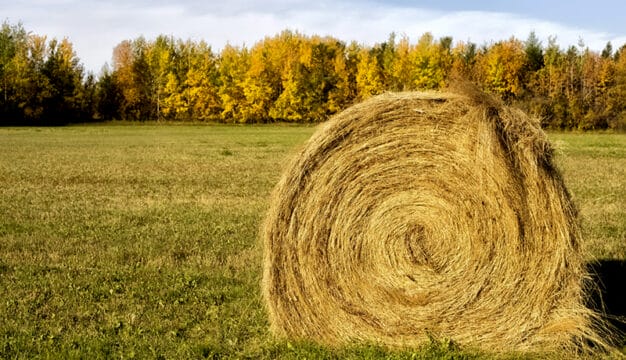Alabama Leather Flower
 Alabama Leather Flower
The Alabama leather flower (Clematis socialis) is a small rare perennial herb in the buttercup family (Ranunculaceae) that is found currently at only at five sites in northeastern Alabama and one site in Floyd County, Georgia. The species was first discovered in the spring of 1980 by botanist Robert Kral in St. Clair County, Alabama. He stopped to examine a roadside site after being drawn to the beautiful blue-violet flowers of this species. A search for more sites turned up a second area in 1985 in Cherokee County. The U.S. Fish and Wildlife Service listed the species as endangered in 1986, citing the small number of sites known at that time and its vulnerability to disturbance because of its roadside habitat.
Alabama Leather Flower
The Alabama leather flower (Clematis socialis) is a small rare perennial herb in the buttercup family (Ranunculaceae) that is found currently at only at five sites in northeastern Alabama and one site in Floyd County, Georgia. The species was first discovered in the spring of 1980 by botanist Robert Kral in St. Clair County, Alabama. He stopped to examine a roadside site after being drawn to the beautiful blue-violet flowers of this species. A search for more sites turned up a second area in 1985 in Cherokee County. The U.S. Fish and Wildlife Service listed the species as endangered in 1986, citing the small number of sites known at that time and its vulnerability to disturbance because of its roadside habitat.
The Alabama leather flower is unique among the genus Clematis, the individual species of which are almost all climbing vines and popular with gardeners. Indeed, the genus name means “vine-branch” in ancient Greek. The Alabama leather flower, in contrast, forms clumps of small upright stems that reach only about a foot tall, rising from an underground network of horizontal stems called rhizomes. The clump-forming nature of the plant explains why the species was named “socialis.” Stems from a single rhizome are genetically identical clones of the original stem. The distinctive bell-shaped flowers are produced singly at the top of the aboveground stems. The accompanying illustration shows some of the species’ important characteristics. The rhizomes (shown with roots in the illustration) produce vertical stems that emerge from the ground, generally in March, as temperatures begin to rise. The plants flower in April and May, produce fruits by June, and then die back to the underground rhizomes again in late summer.
 Alabama Leather Flower Diagram
The rhizomes branch out over time, with the many rhizomes producing large patches of aboveground stems. As with other members of this genus, leaves form on the stems in pairs and vary in shape. Lower leaves are often simple (with a single entire blade), whereas upper leaves are composed of multiple leaflets. The thick, leathery sepals (the structures that encase the flower buds prior to opening) are the source of the species’ common name. Flowers form singly at the tops of some of the stems in the clumps. When pollinated, the flower produces a cluster of hairy single-seeded fruits, or achenes, each about one inch long.
Alabama Leather Flower Diagram
The rhizomes branch out over time, with the many rhizomes producing large patches of aboveground stems. As with other members of this genus, leaves form on the stems in pairs and vary in shape. Lower leaves are often simple (with a single entire blade), whereas upper leaves are composed of multiple leaflets. The thick, leathery sepals (the structures that encase the flower buds prior to opening) are the source of the species’ common name. Flowers form singly at the tops of some of the stems in the clumps. When pollinated, the flower produces a cluster of hairy single-seeded fruits, or achenes, each about one inch long.
This species is found in the Coosa River Valley in damp, silty-clay neutral soils generally in sunny, open, herb-dominated locations. For this reason, scientists believe that fire or other natural disturbances may have been an important factor in the plant’s evolution, as fire would have limited competition, especially from tall woody plants such as trees and shrubs. A study using small-scale burning and mowing at the Dry Creek site showed that the plant is not harmed by either type of management treatment. Scientists haven’t observed new plants growing from seed, and this probably occurs relatively infrequently. Survival of the plant over time depends mainly on the long-lived rhizomes, which in the wild grow about four inches per year. Genetic sampling of plants in large patches revealed that some clones extend as far as 33 feet across. Based upon the slow rate of spread of the rhizomes, researchers at Auburn University, in Auburn, Lee County, have estimated that a single clone of Alabama leather flower can live at least 55 years (and probably much longer).
Production of achenes is limited by a number of factors. Mice eat them, but more importantly the flowers must be pollinated by native bees. A multiyear study at the Dry Creek site found two species of bee involved, with the importance of each species depending on when the weather begins to warm in a particular year. During early springs, flowers are pollinated mainly by the colony-forming bumblebee (Bombus pennsylvanicus), whereas with late springs the solitary miner bee (Anthophora ursina) is the major pollinator. These bees vary in their efficiency, with a miner bee visiting about three times as many flowers per minute as a bumblebee.
Several more sites have been discovered since the species was listed as endangered in 1986, but it is still very rare. A number of factors threaten the species’ existence. Climate change is of great concern because earlier and earlier springs will force the plant to depend on the less efficient bumblebees for pollination and will thus result in even fewer achenes. Also, because they occur largely on roadside right-of-ways, the plants are threatened by mowing, herbicides, and other disturbances. The Nature Conservancy of Alabama acquired the land on which the original plants were discovered and established the Dry Creek Preserve to protect the plants there. Scientists from Auburn University also have developed techniques to propagate the plants by breaking apart and planting sections of rhizome. Living specimens or seeds of the plant are kept by several conservation organizations, including the Birmingham Botanical Gardens, the North Carolina Botanical Garden, the Atlanta Botanical Gardens, the Chattahoochee Nature Center (Georgia), and the Cincinnati Zoo, to ensure that this beautiful species is protected from extinction.
Further Reading
- Boyd, Robert S., and Clayton D. Hilton. “Ecologic Studies of the Endangered Species Clematis socialis Kral.” Castanea 59 (March 1994): 31-40.
- Goertzen, Leslie R., Jennifer L. Trusty, and Robert S. Boyd. “Clonal Diversity and Structure in the Endangered Alabama Leather Flower Clematis socialis Kral (Ranunculaceae).” Journal of the Torrey Botanical Society 138 (January 2011): 41-51.
- Norquist, Cary. Alabama Leather Flower Recovery Plan. Jackson, Miss.: U.S. Fish and Wildlife Service, 1989.
- Trusty, Jennifer L., et al. “Ex Situ Conservation of the Federally Endangered Plant Species Clematis socialis Kral (Ranunculaceae).” Natural Areas Journal 29 (October 2009): 376-84.
- Wall, Michael A., Margaret Timmerman-Erskine, and Robert S. Boyd. “Conservation Impact of Climatic Variability on Pollination of the Federally Endangered Plant, Clematis socialis Kral (Ranunculaceae).” Southeastern Naturalist 2 (Issue 1, 2003): 11-24,



